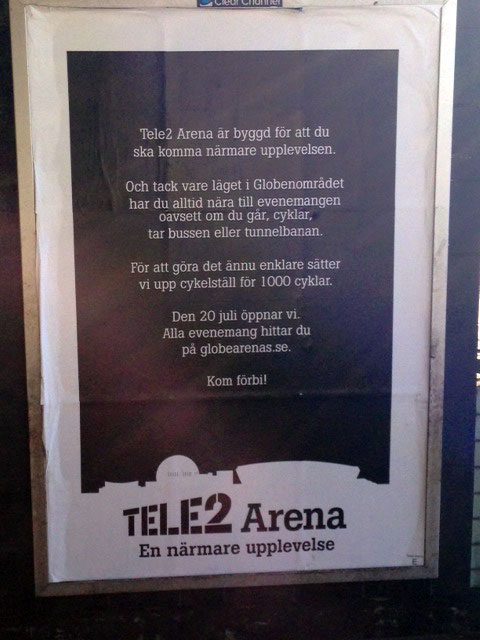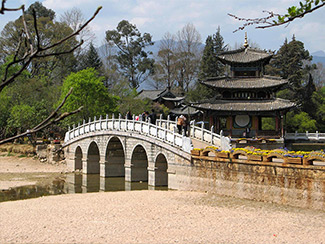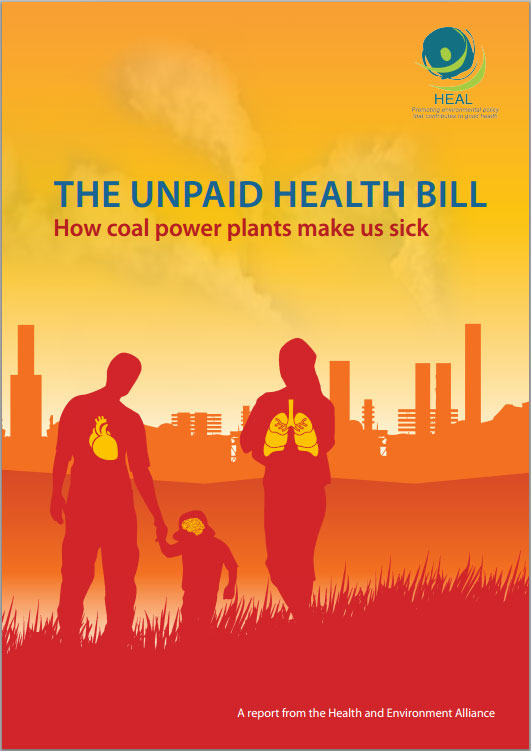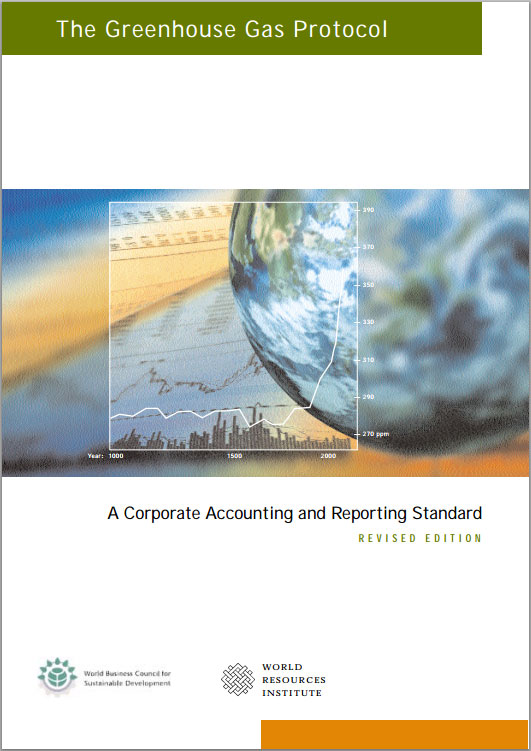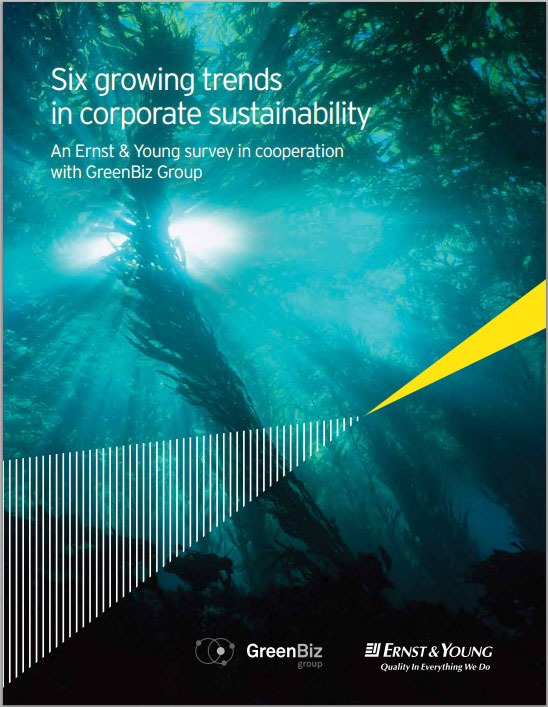The Power of 10 is a concept PPS uses to start off a Placemaking process. The idea is that it’s not enough to have just one great place in a neighborhood- you need a number of them to create a truly lively city or town. It’s not enough to have only one superior neighborhood in a city- you need to provide people all over town with close-to-home opportunities to take pleasure in public life. And, it’s not enough to have one livable city or town in a region- you need a collection of interesting communities.
Tag: TVB Climate Challenge
Tele2arena – Bike racks for 1000 bikes!
There are bright spots in life, new modern (safe) bike racks are regularly being installed in places like underground- train, bus stations.
But newly constructed venues seem to be an exception. It is not cyclist friendly; there is not a bike rack in sight. In a recent press release came from the large Småland furniture manufacturer (IKEA) regarding a trading post built at the southern city of Stockholm in the old slaughterhouse area. Quote from IKEA’s press release. “Its central location also makes the market place becomes easy to reach by public transport ? and in the next breath will notify you that the planned number of parking places is 4000 ?.
The message is: Going by public transport is great, but we are creating up to 4,000 car parking spaces, and have not considered cyclists and their needs.
But there is hope. This is a message in the subway close to IKEA, a new sports arena taking place:
The Tele2 arena have made 1000 bike parking places available from start. Hopefully this is the modern way of planning / thinking, and thus less room for “the bewildered cyclist ?” looking desperately for a space to park his bike – nice.
Drought: What happens when Asias water tower dries up?
Coco Liu, E&E Asia correspondentClimateWire: Tuesday, April 16, 2013
LIJIANG, China — After photographing Black Dragon Lake here for eight years, He Jiaxin knows of more places where he can get the lake to mirror the majesty of its surrounding mountains than anyone else. But this year, he has a problem: The lake has disappeared.
Since its springs dried up last year, no water has flowed into Black Dragon Lake for more than 400 days. At the same time, hot weather caused a high evaporation rate, turning a large part of the lake into a play yard for children.Black Dragon Lake had plenty of water in 2008, before the record drought. Photo courtesy of Gad Ariel.
“Ive never seen such a dry-up before,” He, a 36-year-old local photographer, said while staring at the parched lake bed. “It hasnt rained in Lijiang for a really long time.
“Lijiang is hardly alone. Similar situations are happening across other parts of Yunnan province, which usually has more rain than half of Chinas regions. But it has experienced extremely low rainfall for the past three years.
In the first quarter of this year, Yunnans average rainfall dropped by 70 percent, indicating the start of the droughts fourth consecutive year, according to the water resources department in the region..
via Drought: What happens when Asias water tower dries up? — 04/16/2013 — www.eenews.net.
Coal’s unpaid health bill – Health and Environment Alliance
How is coal pollution making us sick?
A new report launched on 7 March 2013 by the Health and Environment Alliance (HEAL) aims to provide an overview of the scientific evidence of how air pollution impacts health and how emissions from coal power plants are implicated in this. It presents the first-ever economic assessment of the health costs associated with air pollution from coal power plants in Europe as well as testimonies from leading health advocates, medical experts and policy makers on why they are concerned about coal.
The report develops recommendations for policy-makers and the health community on how to address the unpaid health bill and ensure that it is taken into account in future energy decisions.
Download the report here (45 pages):
http://www.env-health.org/IMG/pdf/heal_report_the_unpaid_health_bill_how_coal_power_plants_make_us_sick_final.pdf
The Exhibition at the Crystal
Margaret Thatcher: an unlikely green hero? | John Vidal
The former prime minister helped put climate change, acid rain and pollution onto the mainstream political map
An artist paints a portrait of Margaret Thatcher. Her 11 years in power coincided with a decade of profound national and global environmental change. Photograph: Luke Macgregor/REUTERS
Margaret Thatcher will be remembered for her short lived “green period” in the late 1980s when she helped put climate change (or global warming as it was then known), acid rain and pollution on to the mainstream political map. Tutored by Sir Crispin Tickell, British ambassador to the UN in New York, she made several dramatic environment speeches..
Jonathon Porritt, head of Friends of the Earth in the late 1980s,
via Margaret Thatcher: an unlikely green hero? | John Vidal | Environment | guardian.co.uk.
Greening Fast Food Packaging: A Roadmap to Best Practices
Over the past decade, ever-growing customer demand for green products along with pressure from local community and environmental stakeholders has made sustainability a new corporate imperative.
Across all sectors of the economy, major companies have taken steps to reduce their environmental impact and enhance their green image. With competing brands working to address these concerns, the fast food industry has been no exception.
In the complicated world of corporate sustainability, progress takes work. In some cases, efforts within the fast food industry have resulted in significantly improved environmental outcomes. While in other cases, changes have amounted to little more than greenwashing. This report takes aim at one key area that must be addressed to improve sustainability in the fast food industry: packaging. Special emphasis is placed upon issues surrounding the predominant material for fast food packaging: paper.
CCC-Rdg and “The Greenhouse Gas Protocol” Corporate Standard
Calculation and reporting within the CCC-Rdg will take place according to the GHG Protocol guidelines.
The GHG Protocol Corporate Standard provides standards and guidance for companies and other organizations preparing a GHG emissions inventory. It covers the accounting and reporting of the six greenhouse gases covered by the Kyoto Protocol — carbon dioxide (CO2), methane (CH4), nitrous oxide (N2O), hydrofluorocarbons (HFCs), perfluorocarbons (PFCs), and sulphur hexafluoride (SF6).
Want to know more about the GHG Protocol, see below;
Download the report here (116 pages):
http://www.ghgprotocol.org/files/ghgp/public/ghg-protocol-revised.pdf
Methane hydrate could save the world from fuel crisis
METHANE hydrate has been extracted from frozen deposits under the sea in a world first – raising hopes that the gas could help avert a global fuel crisis.
The form of methane gas was found by Japanese researchers about 50 km (31 miles) from the main island in the Nankai Trough.
Japing beat America, Canada and China, who have all been looking to tap into deposits to provide an alternative energy source.
“It´s the world’s first offshore experiment producing gas from methane hydrate,” said an official from the economy, trade and industry ministry.
At least 1.1trllion cubic metres of methane hydrate exist in offshore deposits, Japan said.
Methane hydrate is a form of methane gas frozen below the seabed or in permanently frozen ground, where the gas is trapped in a network of icy molecules.
There are substantial reserves in regions including the Nankai Trough off Japan’s eastern coast, the northern Gulf of Mexico and Alaska´s North Slope.
Scientists used a technology they developed to reduce pressure in the underground layers holding the methane hydrate 1,330m (4,363ft) below the sea surface.
They then dissolved it into gas and water, and collected the gas through a well. Japan has spent heavily researching the offshore methane hydrate reserves – an endeavor which has taken on more importance since the Fukushima tsunami disaster in 2011 which hit the country´s nuclear energy plans.
by JANE ATHERTON (METRO BUSINESS)
Three more articles with perspectives:
Japan extracts gas from methane hydrate in world first
http://www.bbc.co.uk/news/business-21752441
Methane hydrates – bigger than shale gas, “game over” for the environment?
http://blogs.scientificamerican.com/plugged-in/2013/03/19/methane-hydrates-bigger-than-shale-gas-game-over-for-the-environment/
Frozen Assets
http://www.monbiot.com/2013/03/14/frozen-assets/
Six growing trends in corporate sustainability
Ernst & Young
This report summarizes results based primarily on a survey of the
GreenBiz Intelligence Panel, consisting of executives and thought leaders
in the area of corporate environmental strategy and performance.
Download the report here (30 pages):
http://www.greenbiz.com/sites/default/files/1112-1315117_CCaSS_SixTrends_FQ0029_lo%20res%20revised%203.7.2012.pdf


